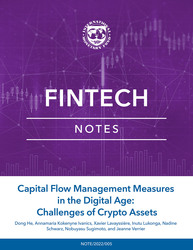
Positioning Central Bank Digital Currency in the Payments Landscape
. This note focuses on the comparison of retail CBDC—that is, the presence of digital central bank money available to the general public—with FPS and e-money systems from a payments perspective, and how CBDC may support a jurisdiction’s vision on payments in the digital age.
READ MORE...
Volume/Issue:
Volume 2024
Issue 006
Publication date: October 2024
ISBN: 9798400289118
$5.00
Add to Cart by clicking price of the language and format you'd like to purchase
Available Languages and Formats
| English |
Prices in red indicate formats that are not yet available but are forthcoming.
Topics covered in this book
This title contains information about the following subjects.
Click on a subject if you would like to see other titles with the same subjects.
Finance , Money and Monetary Policy , Monetary base , Fintech , Payment systems , Financial inclusion , Digital financial services , Infrastructure , Central Bank digital currencies , CBDC , Central bank digital currency , central bank , fast payments , FPS , e-money , digital currencies , digital payments , payment systems
Summary
The IMF is frequently approached by central banks seeking guidance on the balance between central bank digital currency (CBDC), fast payment systems (FPS), and electronic money (e-money) solutions. Common questions arising include: Do central banks need a CBDC when already equipped with other well-established digital payments systems? For central banks with less-developed solutions: Should central banks establish one system over the other? This discussion is then compounded by the reality of constrained resources.
This note focuses on the comparison of retail CBDC—that is, the presence of digital central bank money available to the general public—with FPS and e-money systems from a payments perspective, and how CBDC may support a jurisdiction’s vision on payments in the digital age. The note does not seek to advocate for CBDC over an FPS or e-money. The balance of arguments for any one system may change over time, and the choice may not be mutually exclusive in many jurisdictions. In the future, it is possible to envisage the coexistence of an FPS, e-money, and CBDC in many payment landscapes across the world. Through good design, all three systems could meet central bank objectives such as payments efficiency and supporting financial inclusion; some benefits are unique to CBDC, such as maintaining access to central bank money in an increasingly digitalized age. While central banks will make choices unique to their circumstances, it remains important for central banks to establish a strategy that allows them (at minimum) to monitor trends and core benefits of multiple solutions as developments occur, to allow them to plan, adapt, and drive developments in their payments landscape.
Copyright © 2010 - 2025
Powered by:
AIDC



